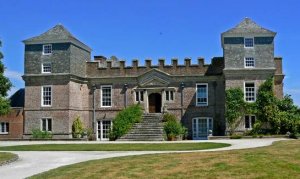
Ince Castle, Elm Gate, Saltash, PL12 4QZ
Tel: (01752) 842672
Email: info@incecastle.co.uk
Web: www.incecastle.co.uk
Proudly overlooking the River Lynher
The land of Ince is mentioned in 1337 as being held by a tenant of the manor of Trematon from the Duchy of Cornwall. But it seems that no house was built on the land until the time of the Civil War.
Apparently the land of Ince was bought by Henry Killigrew in about 1640 to build a house on. It is thought to be the earliest brick house in Cornwall. Ince Castle is at the end of a very attractive peninsula sticking out into the River Lyhner opposite Antony House.
Although military historians do not accept the house as a real castle its design may have been influenced by considerations of defence, especially if it was built, as seems likely, after the outbreak of the Civil War in August 1642. The main walls are nearly four feet thick. Another theory is that this thickness is because the house was originally intended to be a storey higher. Probably it was garrisoned at the time, the Royalists were building batteries at Wearde, Saltash and elsewhere. Plymouth was soon in Parliamentary hands, and Ince was actually besieged and captured from the landward side by Colonel Ralph Welden, governor of Plymouth in August 1646. All the Royalist strongholds in the west were captured during that year. Killigrew surrendered Ince after only a few hours, and afterwards escaped to France, where he soon died.
After his death his estate was confiscated, like that of other Royalists, and complicated legal battles between various parties continued for many years. In 1652 the parliamentary trustees for forfeited estates sold Ince to Edward Nosworthy (1610-1686) a rich Truro merchant who is described as having furnished the house with 'rich furniture, plate, rich tapestry and other hangings and above forty feather beds'. His son, also Edward Nosworthy, eventually became, surprisingly, an adherent of James ll and a Jacobite exile. He died in France in 1701.
The Nosworthys died leaving many debts and the ownership remained disputed in the law courts until 1722 when its ownership was transferred to John Hobart 1st earl of Buckinghamshire (1693-1722). A drawing by Edmund Prideaux, of about 1730, shows the towers three storied with square, battlemented tops, and flat roofs. The middle floor of the towers seems to have been patterned with chevrons in plaster, and traces of rendering can still be seen on the brick west front. Hobart seems to have sold the house to a friend, Pendock Neal of Allerton, Notts, who was married to one of the Eliots of St. Germans, Neal's nephew sold it in 1805 to Edward Smith.
Mary Smith, married to Captain Crease, inherited Ince and lived there until the 1850's when they had to sell. Ince then passed to a series of absentee owners and was let as a farm. It was tumbledown and covered with ivy by the 20th century. It was then bought and, from 1918 substantially remodelled by Mr and Mrs Montague Eliot, later 8th Earl of St. Germans, who re-built the south facade and added a pitched roof and top storey behind the battlements, and built on part of the service wing on the north side.
The present garden is almost entirely the design of Patricia, Lady Boyd, who was a keen plants woman and vice-president of Cornwall Garden Society. She made the formal garden on the south side of the house soon after moving to Ince. Nestling in the corner of the spinney, between the pool and the summer garden, is a dovecote-like building, erected in 1963. Its interior is lined with shells collected by the first Lord Boyd in his colonial days and it is painted with UV varnish to keep their colour, as they fade in natural light.
Patricia Lady Boyd also planted the magnolias, camellias and other shrubs in the woodland garden. In front of the house, towards the River Lyhner, is a wide lawn flanked by a pair of sphinxes (concrete, and bought in a sale from Crowthers of Syon) they were made to go on the Admiralty at the end of the Mall in London, its level has been lowered by the present Lord and Lady Boyd to afford better views of the river from the ground floor of the house. Now beautiful river views can be seen from all parts of the garden and in all the gardens extend to about five acres.
Ince Castle Gardens are open to the public in aid of a charity under the National Gardens Scheme.
Between St. Germans and Saltash over looking the River Lynher.
Opening Times5 Sundays 2.00pm - 5.00pm Admission Charged |
Saltash Antony House River Lyhner Trematon Castle